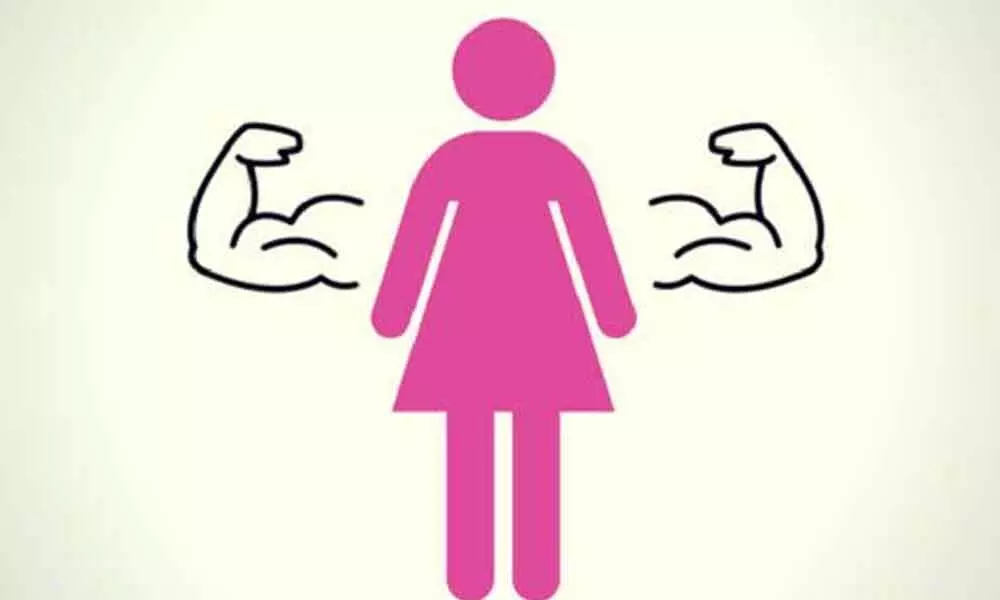Live
- GMR Airports Unveils AI-Powered Digital Twin Platform to Transform Airport Operations
- India poised to become leading maritime player: PM Modi
- Top Causes of Kidney Stones and How to Recognize Silent Symptoms
- India’s renewable energy capacity logs 14.2 pc growth at 213.7 GW
- Winter Session of Odisha Assembly adjourned sine die
- Biden calls Trump's tariff approach 'major mistake'
- After Drama Over Eknath Shinde’s Chief Minister Race, Maharashtra Cabinet Formation Faces New Tensions
- Egyptian FM, Blinken discuss recent developments in Syria
- Iran's supreme leader says Syria's developments result of US-Israeli 'plot'
- Elon Musk to Purchase $100 Million Luxury Mansion Next to Donald Trump's Mar-a-Lago, Report Reveals
Just In
Empowering women is critical to achieve the goal of Atmanirbhar Bharat


Empowering women is critical to achieve the goal of Atmanirbhar Bharat
As the world grapples with Corona with a scramble for suitable drugs, devices, protective equipment and not least discovering a vaccine, India has turned this necessity into a virtue
As the world grapples with Corona with a scramble for suitable drugs, devices, protective equipment and not least discovering a vaccine, India has turned this necessity into a virtue. The government's unveiling of a stimulus package is a step towards attaining self-reliance while battling the pandemic. However, unless women, constituting about half of us are made an integral part of this self-reliance script, Atmanirbhar Bharat will remain a pipe dream.
The persisting unfair deal for the fair sex: economy/employment
Even as the economy has long opened up with 'animal spirits' having been given free rein, whether it has translated into really freeing or emancipating women has remained a big question. Leave aside socio-cultural prejudices and stereotypes, economically speaking, women have barely come to match the levels of workforce participation and benefits as against their male counterparts.
Gender pay-gap the big inhibitor
Though the gender gap has narrowed in terms of education, the employment gap has only widened. In rural India, due to the shrinking of agriculture sector, women's participation is declining too. As a whole, the proportion of women joining the workforce has dropped from 32.2 per cent in 2005 to 23.4 per cent last year.
The disparity in nature-of-work opportunity
Putting money in the hands of women is a morale-booster. Money gives them the autonomy of economic decision-making and purchasing power. Given that women are drivers of 70 per cent of consumer purchase decisions, it has a cascading effect on the larger economy. Yet, the pay-gap has continued. According to a recruitment advisory firm, the gender pay gap in India stood at 19% in the man's favour.
Lamentably, the gap only gets accentuated as one rises up the skillset and experience ladder. This disparity prevailed even in women-centric sectors such as healthcare and social work. In rural areas, in an estimate, a male salaried employee earned nearly 1.4 to 1.7 times a female salaried employee.
The disparity in nature-of-work opportunity
Women are also disadvantaged in terms of the quality or nature of work which is assigned to them. Traditionally considered more suitable for some jobs, they are customarily kept out of the purview of a large number of roles and responsibilities. A study found that most common jobs for urban women involved them as garment workers, domestic cleaners, sales staff and 'directors and chief executives'.
Of those described as directors and chief executives, 99 per cent were self-employed with one-third working as unpaid family workers. Among top ten most common jobs, only teaching employs women substantively.
The lockdown has only deepened the inequality
Incidentally, some of the worst-affected sectors such as hospitality, retail, and personal care, among others, have high presence of women in them. Coupled with the socio-cultural factors such as being primary caretakers at home, the lockdown therefore has disproportionately impacted women as compared to men. Thanks to lockdown, an estimated 40 per cent of women have lost their jobs.
Then women who were employed before lockdown, the chances of their reemployment post-lockdown were 23.5 per cent less than men who were employed in the pre-lockdown phase. Remember, there is an opportunity cost for keeping one half of workforce underemployed/unemployed, which may even be impacting our self-reliance. We should treat Corona as an opportunity.
- Leo Shastri, Director - Operations & Strategy, Usha Exim Private Limited

© 2024 Hyderabad Media House Limited/The Hans India. All rights reserved. Powered by hocalwire.com






